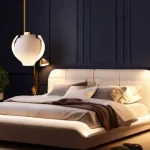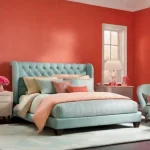When it comes to creating a cozy and inviting bedroom, lighting plays a crucial role. But did you know that choosing the right lighting can also save you money and help the environment?
That’s where energy-efficient bedroom lighting comes into play. By opting for energy-efficient solutions, you can enjoy a well-lit, stylish space without worrying about skyrocketing electricity bills.
Explore the benefits of energy-efficient lighting, introduce you to the different types available, and provide practical tips to help you make the switch.
Whether you’re looking to reduce your carbon footprint or simply want to upgrade your bedroom’s lighting, this post is your go-to resource for making smart, sustainable choices.
Know About Energy-Efficient Lighting
So, what exactly is energy-efficient lighting? Simply put, it’s lighting that uses less energy to produce the same amount of light as traditional options. This means you get the same bright, beautiful illumination while using less electricity.
Energy-efficient lighting is more than just a buzzword; it’s a practical way to cut down on your energy bills and reduce your environmental impact. Here’s why it matters:
- Cost Savings: Energy-efficient lights consume less power, which translates into lower electricity bills. Imagine saving money every month just by switching your bedroom lights!
- Environmental Impact: Using less energy means fewer greenhouse gases and pollutants. By choosing energy-efficient bedroom lighting, you’re contributing to a greener planet.
- Longevity: Energy-efficient lights, like LEDs and CFLs, last much longer than traditional incandescent bulbs. This means fewer replacements and less waste.
For instance, a typical LED bulb can last up to 25,000 hours, compared to only 1,000 hours for an incandescent bulb. That’s a significant difference!
Types of Energy-Efficient Lighting for Bedrooms
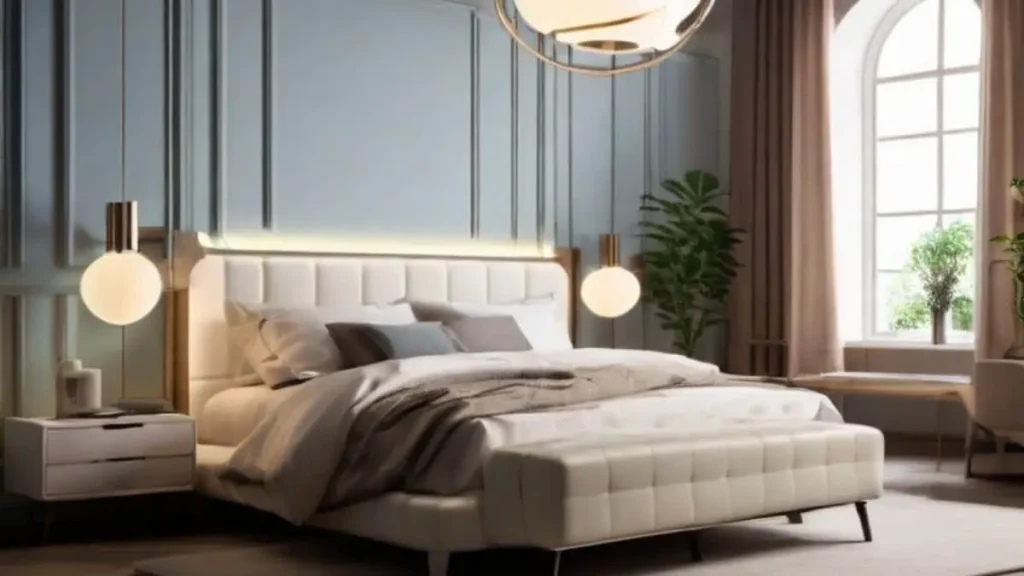
When it comes to energy-efficient bedroom lighting, you have several great options to choose from. Each type offers unique benefits, so you can find the perfect fit for your needs and style. Let’s dive into the most popular choices:
LED Lighting
LEDs (Light Emitting Diodes) are a top choice for energy-efficient lighting. They use up to 75% less energy than traditional incandescent bulbs and last about 25 times longer. That means you’ll spend less on energy and replacements.
Benefits:
- Longevity: LEDs can last up to 25,000 hours.
- Variety: Available in different colors and brightness levels.
- Instant Light: LEDs reach full brightness immediately.
Usage Tips: Consider using LED bulbs for general lighting, task lighting, and even decorative purposes. They’re versatile and can enhance any bedroom design.
CFL Bulbs
CFLs (Compact Fluorescent Lamps) are another energy-efficient option. They use about 70% less energy than incandescent bulbs and have a longer lifespan.
Benefits:
- Cost-Effective: Lower initial cost compared to LEDs.
- Energy Savings: Use about 70% less energy.
- Variety: Available in various shapes and colors.
Usage Tips: CFLs are great for table lamps and overhead fixtures. Just make sure they’re compatible with your existing fixtures.
Smart Lighting Systems
Smart lighting systems take energy efficiency to the next level. These systems often include smart bulbs or fixtures that can be controlled via apps or voice commands.
Benefits:
- Automation: Set schedules and control lights remotely.
- Energy Tracking: Monitor and reduce energy usage.
- Customization: Adjust brightness and color to match your mood.
Usage Tips: Integrate smart lighting with other smart home devices for a seamless experience. Use it to create lighting scenes that match different activities or times of day.
Solar-Powered Lighting
Solar-powered lighting is a fantastic option for sustainable living. While traditionally used outdoors, some solar-powered options are available for indoor use.
Benefits:
- Renewable Energy: Harnesses the power of the sun.
- Cost Savings: Reduces reliance on grid electricity.
- Environmentally Friendly: Minimal environmental impact.
Usage Tips: Ideal for areas with good natural light exposure. Use solar-powered lamps or chargers to complement your existing lighting setup.
Benefits of Energy-Efficient Lighting in the Bedroom
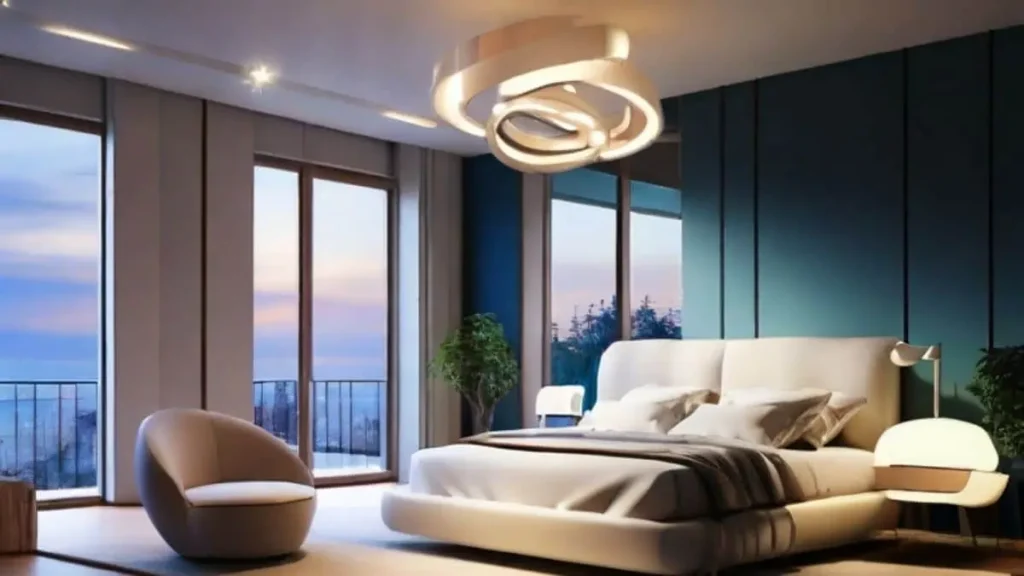
Switching to energy-efficient bedroom lighting offers more than just a lower electricity bill. Here’s how making the change can benefit you:
Cost Savings
One of the most immediate benefits of energy-efficient lighting is the reduction in your electricity bill. For example, if you replace a 60-watt incandescent bulb with a 10-watt LED, you’re saving 50 watts per bulb. Over time, this adds up to significant savings.
Real-World Example: Imagine replacing all the bulbs in your bedroom with LEDs. You could see up to a 75% reduction in energy consumption, leading to lower monthly utility bills.
Environmental Impact
By using less energy, energy-efficient lighting helps reduce your carbon footprint. Less energy consumption means fewer greenhouse gases are produced by power plants.
Statistics: If every household in the U.S. replaced just one incandescent bulb with an LED, it would be equivalent to removing about 1.5 million cars from the road in terms of reduced greenhouse gas emissions.
Enhanced Ambiance
Energy-efficient lighting doesn’t just save money and reduce environmental impact; it can also improve the ambiance of your bedroom. Modern LEDs and smart lighting systems offer a range of color temperatures and brightness levels, allowing you to create the perfect mood for any occasion.
Design Tips: Use warm-colored LEDs to create a cozy atmosphere or cool-toned lights for a more energizing feel. Smart lighting systems can help you adjust the lighting to suit different activities, from reading to relaxing.
Installation Tips for Energy-Efficient Bedroom Lighting

Getting the most out of your energy-efficient bedroom lighting involves more than just picking the right bulbs. Proper installation is key to maximizing both efficiency and ambiance. Here are some essential tips to help you get it right:
Placement Considerations
The placement of your lights can significantly impact both the functionality and energy efficiency of your bedroom.
Tips:
General Lighting: Install energy-efficient bulbs in overhead fixtures or ceiling-mounted lights to provide even, ambient lighting throughout the room.
Task Lighting: Use focused lighting in areas where you read, work, or get dressed. Desk lamps or bedside lamps with energy-efficient bulbs are great choices.
Accent Lighting: Highlight artwork, architectural features, or decorative elements with LED strip lights or spotlights.
Visual Aid: Consider an infographic showing ideal placements for different types of lighting in a bedroom.
Dimming and Control Options
Incorporating dimmers and smart controls can enhance the functionality and efficiency of your lighting setup.
Tips:
- Dimmers: Adding dimmer switches allows you to adjust the brightness based on your needs, reducing energy consumption when full brightness isn’t necessary.
- Smart Controls: Invest in smart bulbs or a smart lighting system that you can control with an app or voice commands. This helps you manage lighting schedules and adjust settings for energy savings.
Practical Tip: When installing dimmers or smart controls, ensure they are compatible with your energy-efficient bulbs. Some bulbs require specific types of dimmer switches to work correctly.
Layered Lighting Approach
Using a combination of different lighting types creates a well-rounded and functional lighting scheme.
Tips:
- Ambient Lighting: This is your main source of light and should be energy-efficient. Consider overhead fixtures or ceiling-mounted LEDs.
- Task Lighting: For activities like reading or grooming, use focused lighting sources like LED desk lamps or adjustable bedside lamps.
- Accent Lighting: Highlight features in your bedroom with LED strips or small spotlights. This adds depth and visual interest while being energy-efficient.
Step-by-Step Guide: Begin by setting up your general lighting, then add task lighting where needed, and finally incorporate accent lighting to enhance the room’s features.
Design Ideas for Energy-Efficient Bedroom Lighting
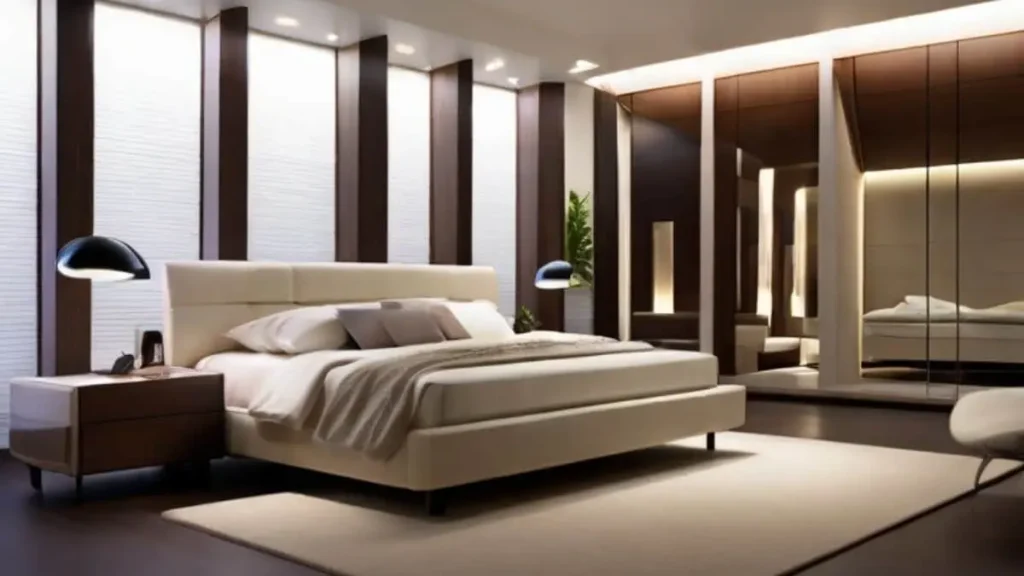
Creating a stylish and functional bedroom with energy-efficient lighting doesn’t mean you have to compromise on design. Here are some ideas to help you combine efficiency with aesthetics:
Modern and Minimalist
For a sleek, modern look, opt for clean lines and simple designs.
Design Concept:
LED Strips: Use LED strips along the edges of shelves or under bed frames for a subtle, contemporary glow.
Recessed Lighting: Install recessed LEDs in the ceiling for a minimalist appearance that provides even, unobtrusive light.
Examples: Picture a bedroom with LED strips behind a floating headboard or recessed lights embedded in a smooth ceiling. This setup combines efficiency with a modern, uncluttered look.
Cozy and Warm
To create a warm and inviting atmosphere, choose lighting that enhances the bedroom’s comfort.
Design Concept:
- Warm-Toned LEDs: Select LED bulbs with a warm color temperature (2700K) to mimic the cozy glow of incandescent bulbs.
- Layered Lighting: Combine warm-toned LEDs with soft, diffused light sources like fabric-covered lampshades.
Examples: Imagine a bedroom with warm-toned LED bulbs in bedside lamps and a ceiling fixture, creating a soft, comforting ambiance perfect for relaxing or unwinding.
Smart Bedroom Lighting
Integrating smart lighting technology allows for a high-tech, customizable lighting experience.
Design Concept:
- Smart Bulbs: Use smart bulbs in various fixtures so you can adjust brightness and color temperature via a smartphone app or voice commands.
- Lighting Scenes: Create customized lighting scenes for different activities or times of day, such as a “Reading” scene with focused light or a “Relax” scene with dim, warm light.
Examples: Visualize a bedroom where smart bulbs are set to change color and intensity based on the time of day or your activity, adding a touch of modern convenience and efficiency.
Incorporating these installation tips and design ideas, you can create a bedroom that not only looks great but also benefits from energy-efficient lighting. Whether you prefer a modern aesthetic, a cozy retreat, or a high-tech setup, there’s an energy-efficient solution to suit your style and needs.
Common Mistakes to Avoid
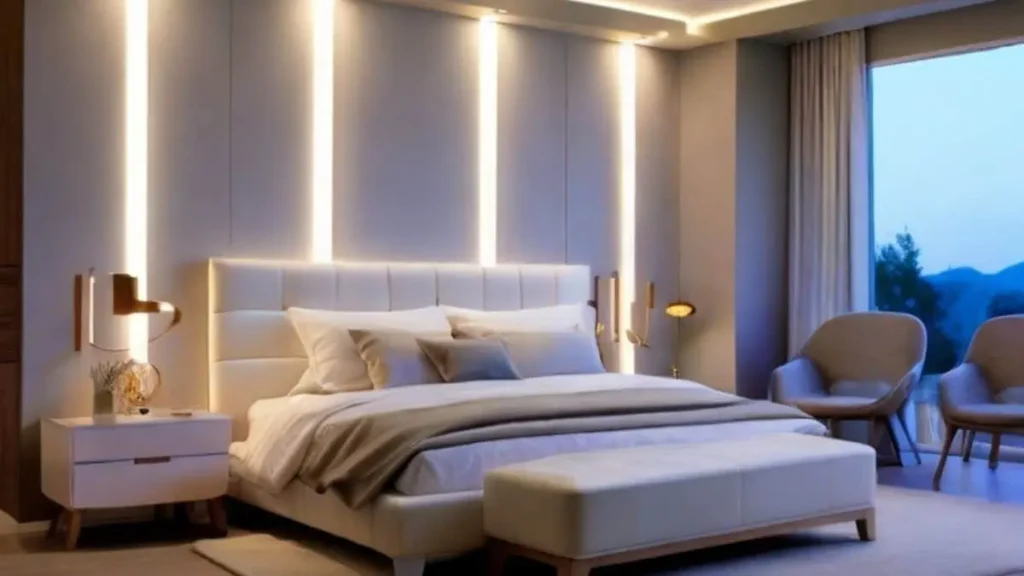
When transitioning to energy-efficient bedroom lighting, avoiding common pitfalls can make the difference between a successful upgrade and a frustrating experience. Here are some frequent mistakes to watch out for:
Overlooking Compatibility
One of the most common mistakes is using energy-efficient bulbs in fixtures that aren’t compatible.
Explanation: Not all fixtures work well with LED or CFL bulbs, especially older models or dimmable switches. Using incompatible bulbs can lead to flickering, reduced performance, or even damage to the bulb or fixture.
Tip: Before purchasing, check the compatibility of your fixtures with the type of energy-efficient bulb you plan to use. For dimmable setups, make sure your bulbs and dimmer switches are compatible.
Ignoring Color Temperature
Another mistake is not considering the color temperature of your energy-efficient bulbs.
Explanation: Different bulbs produce different color temperatures, which can affect the ambiance of your bedroom. For example, cool white bulbs might be too harsh for a relaxing space.
Tip: Choose bulbs with a warm color temperature (2700K) for a cozy bedroom atmosphere. If you prefer a cooler light, opt for bulbs around 4000K. Test different options to find what best suits your room’s mood.
Neglecting Controls
Failing to incorporate controls like dimmers or smart switches can limit the effectiveness of your energy-efficient lighting.
Explanation: Without proper controls, you might not fully utilize the energy-saving potential of your new lighting system. For example, a smart lighting system allows you to adjust brightness and schedules, further enhancing efficiency.
Tip: Install dimmers where possible and consider smart lighting controls to maximize flexibility and efficiency. Ensure that these controls are compatible with your energy-efficient bulbs.
By avoiding these common mistakes, you can ensure that your transition to energy-efficient bedroom lighting is smooth and effective, providing you with both savings and satisfaction.
Conclusion
Embracing energy-efficient bedroom lighting is a practical and rewarding choice that brings multiple benefits. By opting for LED, CFL, smart, or even solar-powered lighting, you not only reduce your electricity bills but also contribute to a more sustainable environment.
Understanding the different types of energy-efficient lighting and implementing smart installation practices can enhance both the functionality and aesthetic of your bedroom.
Avoiding common mistakes, such as compatibility issues and neglecting color temperature, ensures you get the most out of your new lighting setup.


